A Practical Guide to Recording into Text
Turn your audio into accurate text. Our guide covers essential tips for recording into text using powerful AI tools to improve your workflow and results.
Before you even think about hitting "transcribe," the real work begins with capturing clean audio. Honestly, this is the single most important thing you can do to get an accurate, easy-to-use transcript from any AI tool. Nail the recording, and you'll spend far less time cleaning up mistakes later.
Setting the Stage for a Flawless Transcription
The path from a spoken conversation to a clean, written document starts long before you upload a file. The quality of your audio is everything—it directly dictates how well the AI can understand what was said. Think about it: you're asking a machine to listen and type. Garbage in, garbage out.
This means you need to be intentional about your recording setup. Sure, your phone’s built-in mic is fine for a quick voice memo, but for anything important like an interview, a podcast, or a critical meeting, a dedicated USB microphone is a game-changer. The jump in clarity is huge, and you'll see it reflected in the accuracy of your transcript.
Your Recording Environment Matters
Where you record is just as important as what you record with. Rooms with lots of hard surfaces—think hardwood floors, big windows, and bare walls—are echo chambers. That reverb might sound okay to your ear, but it can completely scramble an AI transcription algorithm.
Luckily, a few simple tweaks can make a world of difference:
- Find a "soft" space. A room with carpet, curtains, or even a walk-in closet full of clothes is perfect. These materials absorb sound and kill the echo.
- Shut out the world. Close the doors and windows to block out traffic, hallway chatter, and other random noises.
- Listen for the hum. Your brain is great at tuning out the low hum of a refrigerator, an air conditioner, or a computer fan, but a sensitive microphone will pick it all up.
Getting a clean recording often comes down to knowing how to reduce background noise from your microphone. The less the AI has to filter out, the better it can focus on the voices.
File Formats and Why They Are Important
Not all audio files are created equal. We all know MP3s because they’re small and easy to share, but that small size comes from compression—a process that literally throws away some of the audio data. For transcription, that's bad news.
A high-quality WAV or FLAC file gives an AI tool like Zemith the full picture. With more audio information to work with, it can produce a much more precise and reliable transcript. It’s a small technical choice that pays big dividends in accuracy.
This chart really drives home how much these small setup choices can impact your final transcript.
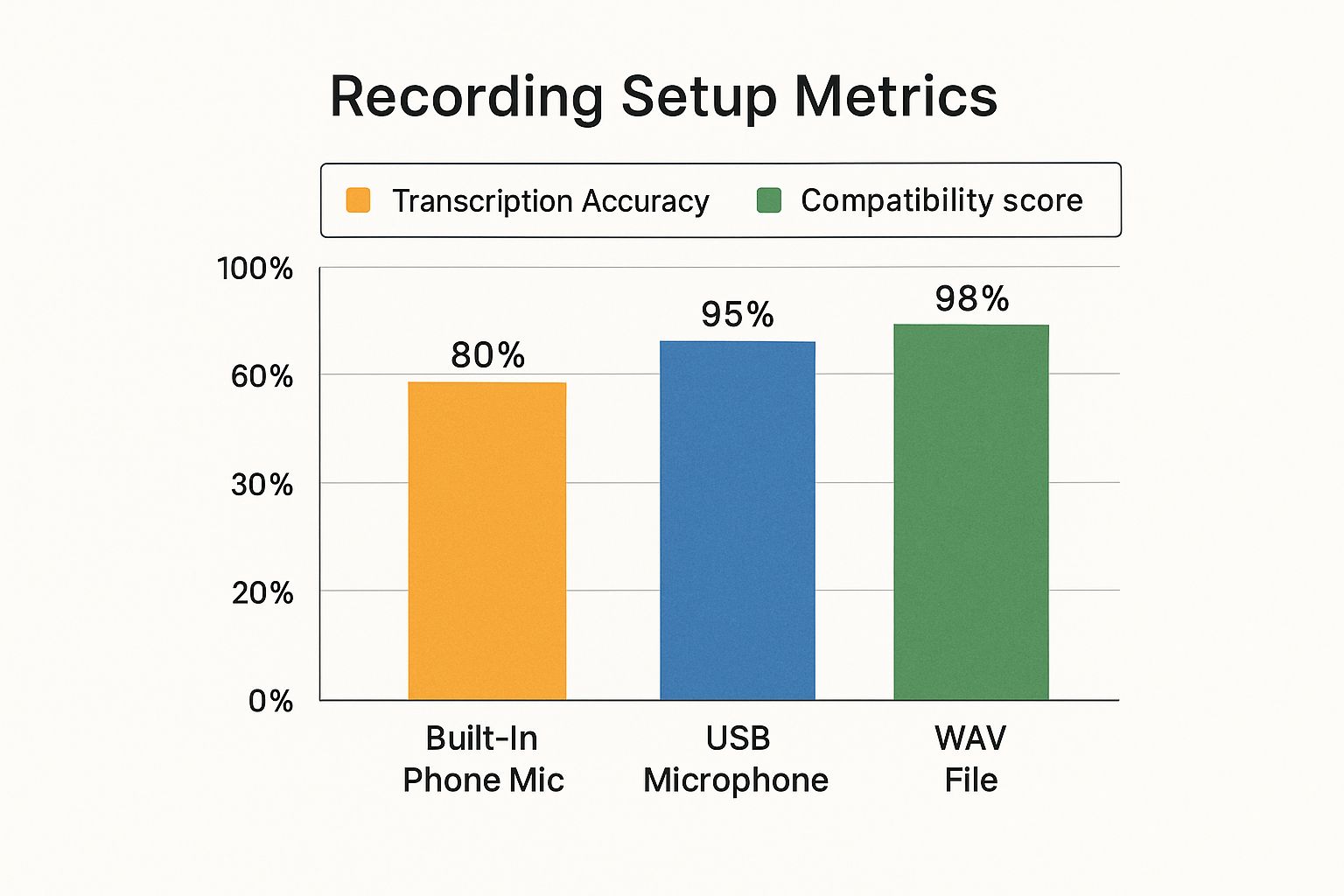
The data doesn't lie. Simply investing in a decent microphone and choosing an uncompressed file format can boost your accuracy by 15% or more. That’s a massive amount of editing time you just saved yourself.
Choosing the Right AI Transcription Tool
https://www.youtube.com/embed/AOBleAHz2hE
With so many transcription services popping up, picking the right one can feel like a shot in the dark. It’s tempting to just compare per-minute rates, but that rarely tells the whole story. The real value isn't just in the raw transcript; it's in the features that genuinely save you time and effort. A professional-grade platform like Zemith is a complete workspace, not just an algorithm.
The tech behind all this has come a long way. Early speech recognition systems, like the Hidden Markov Model from the 1980s, were a huge leap forward. They expanded system vocabularies from just a few hundred words to around 20,000, which was a massive deal at the time. This laid the groundwork for everything from IBM's early voice-activated typewriters to the sophisticated AI we rely on today.
This long history means today's tools are packed with features that go way beyond a simple text file. As you shop around, checking out services like Parakeet AI's transcription service can give you a good sense of the current landscape.
Going Beyond a Basic Text Dump
Let's be honest: a raw, unformatted block of text isn't very useful. The best tools are the ones that understand the context and structure of a real conversation.
Think about what you actually need from a platform like Zemith:
- Who said what? Accurate speaker identification is a must-have for any recording with more than one person. Without it, you’re left with a confusing mess of dialogue. This is critical for interviews, meetings, and panel discussions.
- When did they say it? Precise timestamps are your best friend. They let you jump straight to a specific moment in the audio to clarify a word or catch the speaker's tone, saving you from the headache of scrubbing back and forth.
- Can it handle real-world speech? People have accents. Industries have jargon. A powerful AI needs to be trained on diverse datasets to keep up without its accuracy taking a nosedive.
I once worked with a research team that was drowning in focus group recordings. By using Zemith, they could lean on its speaker labeling to see who was driving the conversation and use the collaborative editor to pull key insights together. It literally saved them days of manual sorting.
Don't Overlook Security and Team Features
If you’re transcribing sensitive interviews or confidential meetings, security can't be an afterthought. You need to look for a service with enterprise-grade encryption and a privacy policy that’s crystal clear. Your data integrity is non-negotiable.
Here’s a look at the Zemith interface. Notice how it’s designed to be clean and straightforward, so you can manage your projects without getting bogged down in confusing menus.
The layout is all about clarity, making it simple to find what you need and get to work.
Finally, think about how your team will use the transcript. A platform like Zemith that bakes a smart editor right into the workflow is a game-changer. It means your whole team can review, leave comments, and polish the final text all in one place. No more emailing different versions back and forth.
To help you decide, here’s a quick comparison of what you can expect from different types of tools.
Comparing Key Features of AI Transcription Tools
Choosing between a basic tool and a comprehensive platform like Zemith often comes down to what you need to accomplish after the initial transcription is done. This table breaks down the key differences.
| Feature | Basic AI Tool | Zemith (Advanced Platform) | Why It Matters |
|---|---|---|---|
| Speaker Identification | Often generic ("Speaker 1, Speaker 2") or none | Accurate, nameable speaker labels | Crucial for understanding who said what in interviews, meetings, and focus groups. |
| Timestamp Accuracy | Word-level, but can be inconsistent | Highly precise, paragraph- and word-level timestamps | Saves you time when you need to reference the original audio for context or clarity. |
| Collaborative Editor | Not available; requires exporting to another app | Built-in editor for real-time team comments and edits | Keeps the entire workflow in one place, preventing version control chaos. |
| Custom Vocabulary | Limited or non-existent | Add custom terms, names, and industry-specific jargon | Dramatically improves accuracy for specialized content (medical, legal, technical). |
| Security & Compliance | Basic security protocols | Enterprise-grade encryption and clear privacy policies | Protects sensitive information and ensures your data is handled responsibly. |
| Integration & Export | Limited formats (e.g., .txt, .docx) | Multiple export formats (SRT, VTT) and potential API access | Gives you the flexibility to use your transcript in different applications. |
As you can see, while a basic tool might get the words down, an advanced platform like Zemith is designed to support your entire process, from upload to the final, polished document.
If you’re serious about making your workflow more efficient, you’ll want a tool that does more than just transcribe. For a deeper look at this, check out our guide on how AI can turn your audio into text. Making the right choice upfront will save you countless hours down the road.
From Audio File to Draft Transcript
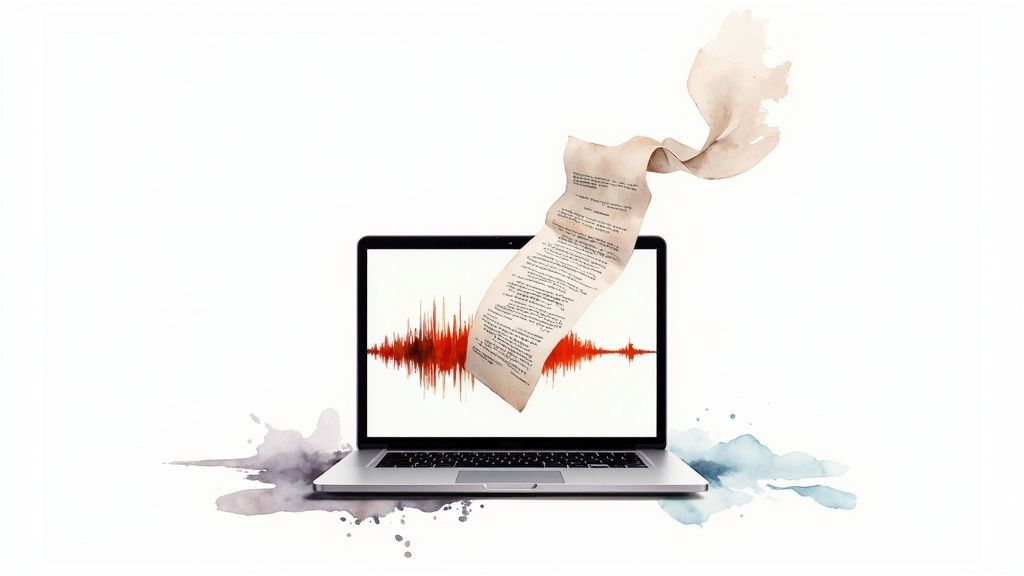
This is where all that careful prep work you did recording your audio pays off. You’ve got a clean file, and now it's time to let the technology take over. With a good platform, getting from a recording to text is surprisingly easy. The AI does the heavy lifting; you just need to get the process started.
Most transcription tools give you two ways to work: you can either upload a file you've already recorded or capture audio as it happens. For most of us transcribing interviews, meetings, or lectures, uploading a pre-recorded file is the way to go. It just gives you more control. The live option is fantastic for things like generating meeting notes on the fly.
Let’s walk through the upload workflow, since that’s where most people spend their time.
The Upload and Configuration Process
Picture this: you're a journalist with a one-hour interview and a looming deadline. The last thing you need is a clunky, confusing interface. This is where a clean tool like Zemith really makes a difference. A simple drag-and-drop is all it takes to get your file in the system.
Once your file is loaded, you'll see a few basic settings. They might seem minor, but getting these right is crucial for a good first draft.
- Select the Language: First, tell the AI what language is being spoken. This simple choice ensures it uses the right vocabulary and grammar models.
- Specify Speaker Count: If you know how many people are speaking, punch in that number. This helps the AI with speaker diarization—the technical term for figuring out who is talking and when.
Nailing these two details right out of the gate saves a ton of cleanup time later. It's a classic case of a minute of prevention being worth an hour of cure.
With a platform like Zemith, you can also add custom vocabulary—like specific company names or technical jargon—before you even start. This gives the AI the exact brief it needs to do its job well, resulting in a much cleaner transcript from the start.
Avoiding Common Upload Pitfalls
Even with a straightforward process, a couple of snags can catch you off guard, especially when you're in a hurry. For that journalist on a deadline, a failed upload could be a disaster.
Here are a few things I've learned to watch out for:
- Unsupported File Types: Always check what formats the platform accepts. Most tools are happy with MP3, WAV, and MP4, but if you try to upload something less common like a WMA file, it'll probably fail. A quick file conversion is an easy fix if you run into this.
- Unstable Internet Connection: Large audio files need a solid, steady connection to upload properly. A flaky Wi-Fi signal can corrupt the file halfway through, and you'll have to start all over again. If you have a big file, I always recommend plugging directly into an ethernet cable if you can.
Keeping an eye on these little details makes for a smooth handoff from your audio file to the AI. What you get back is a solid, structured draft ready for you to polish, bringing you one big step closer to your final goal.
How to Edit Your Transcript Like a Pro

An AI-generated transcript is a fantastic starting point, but it's almost never the final version. That last polish, the human touch, is what separates a decent transcript from an exceptional one. This isn't about rewriting everything from scratch; it’s about a smart, targeted review to nail down clarity, accuracy, and readability.
Think of it this way: AI is brilliant at recognizing words, but it often misses the nuance of human intent and context. Your job is to fill in those gaps. This cleanup process is what turns the raw output from your recording into text into a professional document you can actually rely on.
A Smarter Editing Workflow
Instead of just reading the whole thing from start to finish, you can save a ton of time by zeroing in on the most common mistakes AI makes. This approach concentrates your effort where it matters most.
Here's a practical checklist to guide your edit:
- Speaker Labels: Did the AI get every speaker right? This is a big one, especially for interviews with multiple people. A quick scan to correct any mislabeled sections is your first priority.
- Proper Nouns and Jargon: AI often fumbles unique names, company-specific acronyms, or niche industry terms. A simple find-and-replace can fix these inconsistencies throughout the entire document in seconds.
- Homophones and Awkward Phrasing: Words that sound alike—like "their," "there," and "they're"—are classic trip-ups. You’ll also want to watch for phrases the AI heard literally but that don't make sense in context.
This is where having the right tool makes all the difference. A platform like Zemith streamlines this process with an interactive editor that links the text directly to the audio. If a sentence feels clunky or just plain wrong, you can click on any word and instantly hear the original recording at that exact spot. It's a massive time-saver compared to manually scrubbing through a separate audio file.
The real power of editing isn't just fixing typos. It's about shaping the text to perfectly reflect the meaning and tone of the original conversation, ensuring nothing gets lost.
The technology driving this accuracy has come a long way. The rise of deep neural networks in the 2010s was a turning point, drastically cutting down word error rates. In fact, some systems achieved error rates as low as 5.9% on conversational speech, which is getting remarkably close to human-level accuracy.
The Final Polish for Readability
After you've stamped out the main errors, it's time for one last read-through focusing on flow and punctuation. AI-generated punctuation can be a bit chaotic, so you'll likely need to add commas, periods, and new paragraphs to guide the reader's eye.
This final step is all about the reader's experience. Breaking up a long monologue into shorter paragraphs or pulling out key ideas into a bulleted list can make a wall of text much easier to digest. For more tips on making your final document sharp and professional, check out our guide on how to edit your writing effectively. This quick pass ensures your transcript is not just accurate, but genuinely useful.
Putting Your Final Transcript to Work
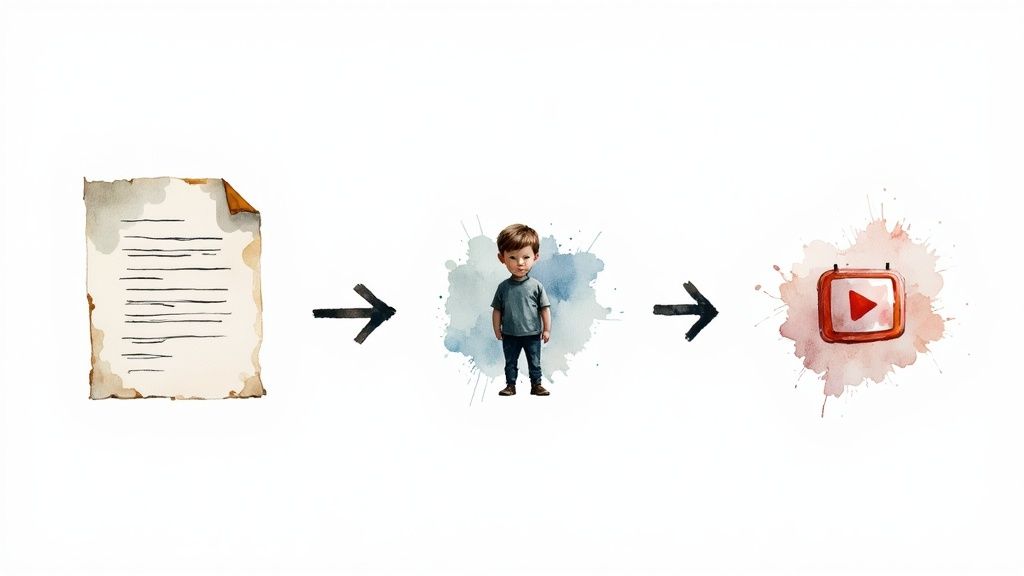
A polished transcript is so much more than a simple record of a conversation. It’s a versatile digital asset, brimming with potential. Once you’ve cleaned up and finalized the text, the real fun begins—deploying it across different channels. This is where you start working smarter, not harder, by getting the most value out of a single audio recording.
Don't think of the transcript as the finish line. See it as the starting block for a whole new race of content creation. That one-hour expert interview or webinar doesn't have to just live and die as a single video. Its transcript is the foundation for so much more.
Unlocking Content Repurposing Opportunities
Imagine taking that single webinar and spinning it into multiple pieces of high-value content. You can pull out the most compelling points and flesh them out into a detailed, SEO-friendly blog post. This tactic doesn't just save you a ton of time; it also helps build your website's authority by publishing expert insights.
From there, the possibilities just keep expanding.
- Social Media Gold: Snag short, punchy quotes and turn them into eye-catching graphics for LinkedIn, Instagram, or X.
- Internal Knowledge: Summarize the key takeaways into an internal training document or a quick-reference guide for your team.
- Video Accessibility: The transcript is your best friend for creating accurate subtitles, opening up your video content to a much wider audience.
This entire workflow is made incredibly smooth with a tool like Zemith, which gives you flexible export options. You can download your text in whatever format you need—.docx for articles, .txt for raw text, or even .srt files designed specifically for video captions. It just removes all the technical headaches from the process.
The big idea here is simple: one recording, many outcomes. By strategically repurposing your transcribed text, you multiply your content output without doubling your effort. It’s all about making sure every minute of that original recording delivers maximum impact.
A Marketer’s Secret Weapon for SEO
Let's walk through a real-world scenario. A content marketer lands an insightful interview with an industry leader. After turning the recording into text with an AI tool, they're left with a perfect, word-for-word transcript.
Instead of just uploading the audio file and calling it a day, they use the text to craft a long-form article for the company blog. They sprinkle in relevant keywords, add some internal links, and break it up with clear headings. Just like that, a great conversation becomes a powerful SEO asset that can pull in organic traffic for months, or even years.
You can even take it a step further. The audio itself can be repurposed, which you can learn more about in our guide on how to turn text into a podcast. This multi-format strategy boosts your visibility and cements your company's reputation as a thought leader—all from one initial recording.
Your Top Questions About Turning Audio into Text
As you dive into transcribing your recordings, a few common questions always seem to pop up. Let's tackle them head-on, so you can get the best possible results right from the start.
How Fast Can I Get My Transcript?
The speed of today’s AI is one of its biggest selling points. A tool like Zemith can whip through a one-hour audio file in just a few minutes. Think about that for a second—a task that would take a seasoned human transcriber 4-6 hours is done in less time than it takes to make a cup of coffee.
Of course, the AI gives you the first draft. The final turnaround time really depends on how much cleanup is needed on your end. A crystal-clear recording from the get-go means a much faster and more accurate process overall.
What About Different Accents or Multiple People Talking?
This is where modern AI truly shines. The best platforms are built with something called speaker diarization, which is just a fancy way of saying they can automatically figure out who is speaking and when.
Modern AI is trained on massive datasets filled with global accents and speech patterns. This is why it can achieve such high accuracy across a huge range of voices. The key is to make sure everyone is speaking clearly and not talking over each other.
Zemith, for instance, is designed to pick up on these nuances, effortlessly turning a messy, multi-person conversation into a neatly organized script.
How Do I Handle Confidential Recordings?
When you're dealing with sensitive information, security is non-negotiable. You absolutely have to choose a service with robust security measures and a clear privacy policy you can actually understand.
Here’s what to look for:
- End-to-end encryption: This keeps your file locked down from the moment it leaves your computer.
- Private server processing: Your data should never be floating around on shared or public systems.
Established platforms like Zemith are built from the ground up with security in mind. This makes them a far safer bet than those free, browser-based tools that might not offer the same level of protection for your private information.
Can I Transcribe a Video File?
You sure can. Most professional transcription services handle both audio and video files without any extra steps. Just upload a common video format like MP4 or MOV, and the platform will automatically pull out the audio track and get to work.
This is a game-changer for so many tasks. You can quickly generate captions for social media videos, add subtitles to make your content more accessible, or create detailed written summaries of things like webinars and online courses.
Ready to turn your audio and video files into text you can actually use? With Zemith, you’re getting a secure, powerful, and ridiculously easy-to-use platform that brings all your transcription work into one place. It’s time to stop the manual grind and start pulling real value from your recordings.
Explore Zemith Features
Introducing Zemith
The best tools in one place, so you can quickly leverage the best tools for your needs.
All in One AI Platform
Go beyond AI Chat, with Search, Notes, Image Generation, and more.
Cost Savings
Access latest AI models and tools at a fraction of the cost.
Get Sh*t Done
Speed up your work with productivity, work and creative assistants.
Constant Updates
Receive constant updates with new features and improvements to enhance your experience.
Features
Selection of Leading AI Models
Access multiple advanced AI models in one place - featuring Gemini-2.5 Pro, Claude 4.5 Sonnet, GPT 5, and more to tackle any tasks
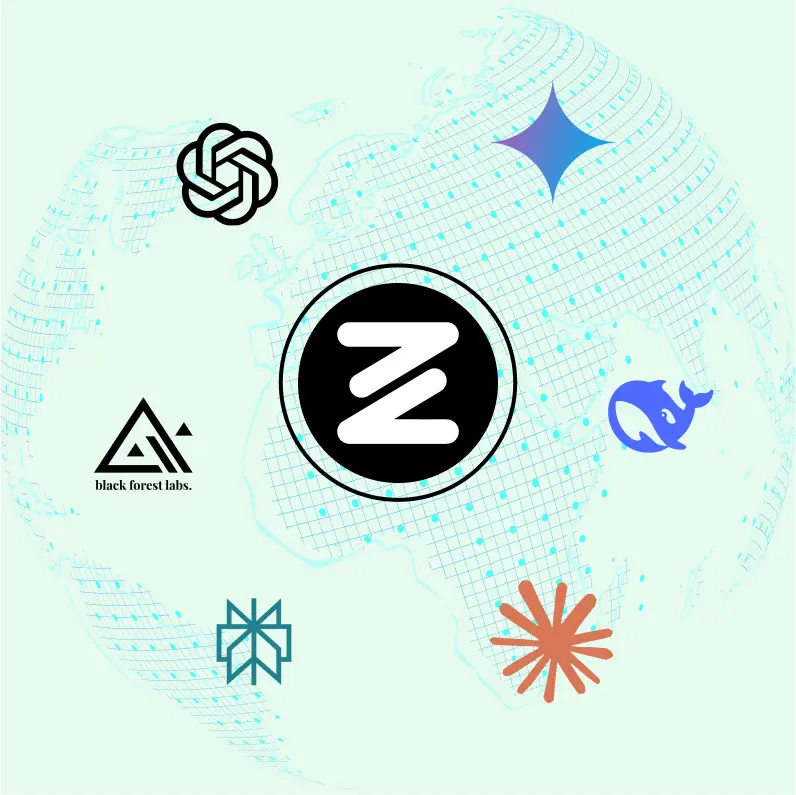
Speed run your documents
Upload documents to your Zemith library and transform them with AI-powered chat, podcast generation, summaries, and more
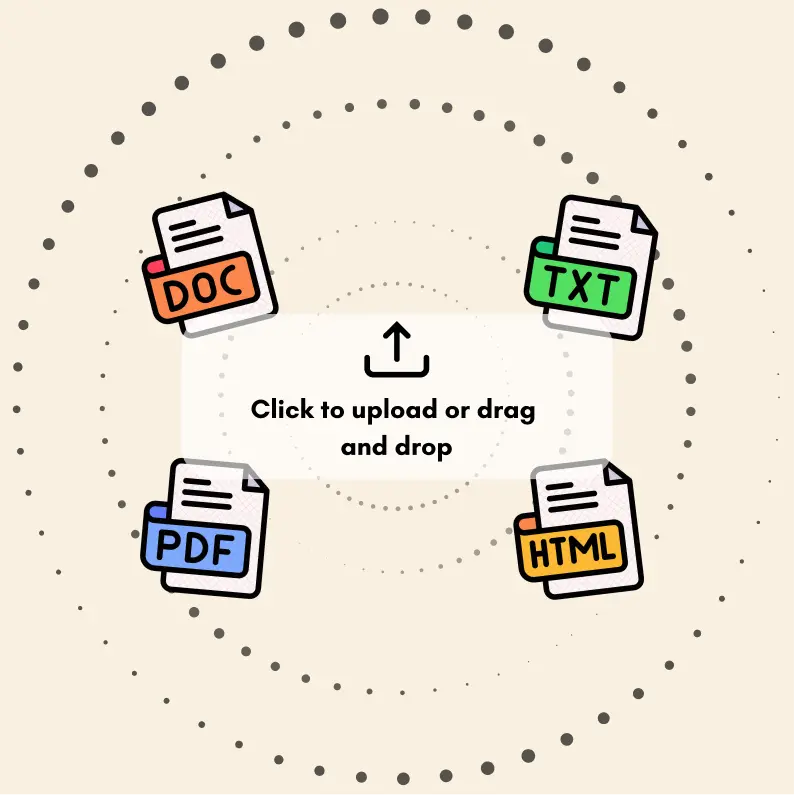
Transform Your Writing Process
Elevate your notes and documents with AI-powered assistance that helps you write faster, better, and with less effort

Unleash Your Visual Creativity
Transform ideas into stunning visuals with powerful AI image generation and editing tools that bring your creative vision to life

Accelerate Your Development Workflow
Boost productivity with an AI coding companion that helps you write, debug, and optimize code across multiple programming languages

Powerful Tools for Everyday Excellence
Streamline your workflow with our collection of specialized AI tools designed to solve common challenges and boost your productivity
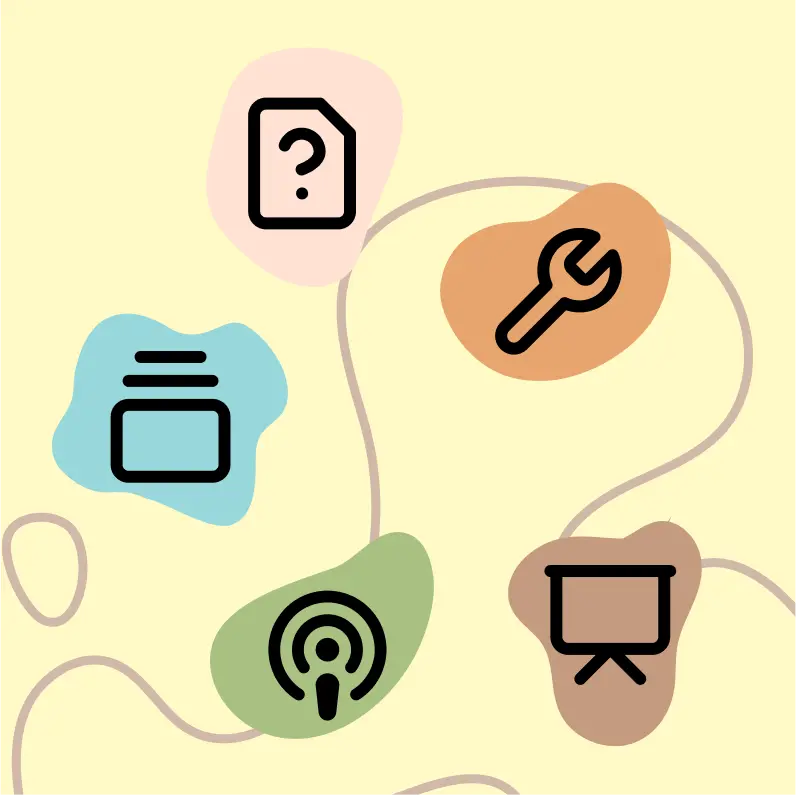
Live Mode for Real Time Conversations
Speak naturally, share your screen and chat in realtime with AI

AI in your pocket
Experience the full power of Zemith AI platform wherever you go. Chat with AI, generate content, and boost your productivity from your mobile device.

Deeply Integrated with Top AI Models
Beyond basic AI chat - deeply integrated tools and productivity-focused OS for maximum efficiency
Straightforward, affordable pricing
Save hours of work and research
Affordable plan for power users
Plus
- 10000 Credits Monthly
- Access to plus features
- Access to Plus Models
- Access to tools such as web search, canvas usage, deep research tool
- Access to Creative Features
- Access to Documents Library Features
- Upload up to 50 sources per library folder
- Access to Custom System Prompt
- Access to FocusOS up to 15 tabs
- Unlimited model usage for Gemini 2.5 Flash Lite
- Set Default Model
- Access to Max Mode
- Access to Document to Podcast
- Access to Document to Quiz Generator
- Access to on demand credits
- Access to latest features
Professional
- Everything in Plus, and:
- 21000 Credits Monthly
- Access to Pro Models
- Access to Pro Features
- Access to Video Generation
- Unlimited model usage for GPT 5 Mini
- Access to code interpreter agent
- Access to auto tools
- 10000 Credits Monthly
- Access to plus features
- Access to Plus Models
- Access to tools such as web search, canvas usage, deep research tool
- Access to Creative Features
- Access to Documents Library Features
- Upload up to 50 sources per library folder
- Access to Custom System Prompt
- Access to FocusOS up to 15 tabs
- Unlimited model usage for Gemini 2.5 Flash Lite
- Set Default Model
- Access to Max Mode
- Access to Document to Podcast
- Access to Document to Quiz Generator
- Access to on demand credits
- Access to latest features
- Everything in Plus, and:
- 21000 Credits Monthly
- Access to Pro Models
- Access to Pro Features
- Access to Video Generation
- Unlimited model usage for GPT 5 Mini
- Access to code interpreter agent
- Access to auto tools
What Our Users Say
Great Tool after 2 months usage
simplyzubair
I love the way multiple tools they integrated in one platform. So far it is going in right dorection adding more tools.
Best in Kind!
barefootmedicine
This is another game-change. have used software that kind of offers similar features, but the quality of the data I'm getting back and the sheer speed of the responses is outstanding. I use this app ...
simply awesome
MarianZ
I just tried it - didnt wanna stay with it, because there is so much like that out there. But it convinced me, because: - the discord-channel is very response and fast - the number of models are quite...
A Surprisingly Comprehensive and Engaging Experience
bruno.battocletti
Zemith is not just another app; it's a surprisingly comprehensive platform that feels like a toolbox filled with unexpected delights. From the moment you launch it, you're greeted with a clean and int...
Great for Document Analysis
yerch82
Just works. Simple to use and great for working with documents and make summaries. Money well spend in my opinion.
Great AI site with lots of features and accessible llm's
sumore
what I find most useful in this site is the organization of the features. it's better that all the other site I have so far and even better than chatgpt themselves.
Excellent Tool
AlphaLeaf
Zemith claims to be an all-in-one platform, and after using it, I can confirm that it lives up to that claim. It not only has all the necessary functions, but the UI is also well-designed and very eas...
A well-rounded platform with solid LLMs, extra functionality
SlothMachine
Hey team Zemith! First off: I don't often write these reviews. I should do better, especially with tools that really put their heart and soul into their platform.
This is the best tool I've ever used. Updates are made almost daily, and the feedback process is very fast.
reu0691
This is the best AI tool I've used so far. Updates are made almost daily, and the feedback process is incredibly fast. Just looking at the changelogs, you can see how consistently the developers have ...
